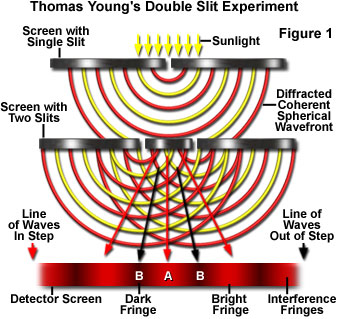Double
Slit Experiment
In the 1800s, Thomas Young gave
the world a strong idea that support that light was a
type of wave.
During this experiment, Thomas Young allowed a beam of
sunlight to pass through a screen with two slits.
This sunlight then cast a shadow on
the wall behind the apparatus.
If light was a particle then we
expected to make two lines of light. Young found that
the light diffracted as it passed through the slits, and
then interfered with itself, producing a bright and dark
bands on the screen.

If we notice in the image above, at some points the two
sets of waves meet crest to crest and others the crest
will meet half though. Where crest meets crest, a
constructive interference occurs causing a bright spot
to be view in the screen. Where crest meets through, a
destructive interference that cancel each other causing
black spot to appear in the screen.
This
concluded that light consists of waves and not particles
because only waves were known to diffract and interfere
like light did during this experiment.
Although, Young's idea wasn't accurate for what
light really is, it open the world to the definition of it. Base on
this experiment, Albert Einstein was able to come to the
conclusion after installing detectors at the slits,
Einstein observed that each photon of light only
passed through one of the slits, which is a particle
behavior rather than a wave-like behavior. At this point quantum physics has
manipulated our intuition to the point that everything
didn't make sense.
At this point quantum physics has
manipulated our intuition to the point that everything
didn't make sense.
If we combine the idea of Young, Maxwell and Einstein we
end up that light is a particle that also
behaves like a wave traveling really fast.